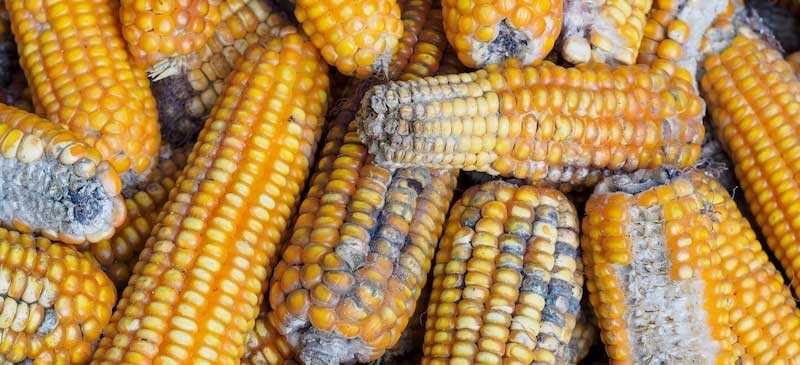
Aflatoxin is a type of mold that is considered a human carcinogen. It’s found in certain commonly eaten foods, including peanuts, peanut butter and corn, and is most harmful in parts of the world where people consume large amount of these foods, such as Asia and Africa.
The species of molds that combine to form aflatoxin grow in soils when conditions are just right, including when decaying food, plants, hay and grains are piled together to decompose in areas with high moisture and high temperatures.
There are actually at least 13 different types of naturally occurring aflatoxin toxic molds that researchers have been able to identify. Of the 13 species, the type called aflatoxin B1 is considered the most toxic, capable of causing health problems such as liver disease or cancer, autoimmune responses, digestive issues, and in rare cases even death.
Research has shown that consuming aflatoxin through the food supply is one of the major causes of liver disease (specifically the type called hepatocellular carcinoma) in certain countries, such as China and Africa.
What can you do to avoid aflatoxin and lower the risk for symptoms it can cause (such as allergies and fatigue)? Aflatoxin enters the body through certain widely available foods, especially grains and legumes, so making changes to your diet is the first step. Secondly, certain supplements can also help the body detoxify itself of aflatoxin and raise immunity against its effects.
What Is Aflatoxin?
Chemically speaking, aflatoxin is a type of “mycotoxin” that is produced by two different species of mold: Aspergillus flavus and Aspergillus parasiticus. There are natural molds found around the world and concentrated most in the human food supply in areas with wet and warm climates. It’s also possible for aflatoxin mold to form in grains grown under poor conditions, such as those experiencing droughts.
The strains of aflatoxin most common in foods include B1, B2, G1 and G2. After humans or other mammals consume aflatoxin, metabolic processes turn it into metabolites M1 and M2, which have ” high carcinogenic potential.” The International Agency for Research on Cancer has classified aflatoxin B1 as a “Group I carcinogen” that’s capable of raising the risk for cancer.
Aflatoxin seems to affect the ways that cells reproduce and also targets the liver, affecting the way that other substances are metabolized and eliminated, possibly increasing food allergy reactions.
There are many different types of molds and fungus that can grow in food, including various species of mycotoxins, but aflatoxin has gained attention more than most others because studies have found clear evidence of its potential for causing carcinogenic effects. In animal studies, high levels of aflatoxin consumption has been shown to be poisonous, and in human observation studies aflatoxin consumption correlates with an increased the risk for certain illnesses and dangerous symptoms.
Over the past century or so, there have also been several occurrences when large populations of livestock (cattle, ducks, chicken, etc.) have died due to contamination of their food supplies, especially peanut flour or cottonseed, which can sometimes become home to a dozen different strains of aflatoxin.
Unfortunately, aflatoxin makes its way into some popular “healthy” foods that aren’t actually healthy. The level of aflatoxin contamination in any given food will vary with geographic location, along with how the food was grown.
Additionally, once crops are picked, it matters how they are handled, processed and stored, since all of these can affect whether or not aflatoxin is able to survive and thrive. Some research shows that crops being grown in humid locations, such as Brazil and China, are most likely to contain aflatoxin.

Is It Regulated?
Wondering if the U.S. Food and Drug Administration (FDA) or any other governing/health authority does anything to control the spread of aflaxotin in the human supply?
In many countries, regulations have been put into play to help limit exposure to aflatoxins by testing and properly harvesting and processing foods known to be contaminated. The FDA has set “actionable limits” (maximum tolerable level of total aflatoxins) for foods like corn and peanuts to try and control how much aflatoxin is can make its way into available foods sold to humans and used for livestock feed.
Food suppliers also try to lower risk for contamination by keeping crops from becoming overly moist and warm, harvesting food when it’s ripe (crop drying and mold growth can occur if crops are left too long and dry out), and preventing bugs and rodents from accessing the crops and spreading molds.
According to the Official Journal of the Society of Toxicology, most nations allow a range of aflatoxin in corn and peanuts between 4 to 20 ng/g. However there’s evidence that this amount doesn’t do enough to protect everybody, especially people living in underdeveloped countries where these crops are consumed in high amounts and immunity is already low for other reasons.
Some researchers feel that “most current regulatory standards are not adequately protective even if enforced” considering that more than one in 100,000 people in some nations are believed to be at risk for experiencing life-threatening aflatoxin poisoning.
Symptoms and Health Risks
People living in third world countries are most likely to be impacted by the negative effects of aflatoxin poisoning, but this doesn’t mean that developed nations are totally safe. The consumption of “staple crops” that can contain aflatoxin, such as corn and peanuts, are used globally, and even a small of aflatoxin in the food supply can wind up spreading and causing problems. How badly a person is affected by aflatoxin will depend on factors like her current state of health, level and duration of exposure, strength of her immune and digestive system, and overall quality of her diet.
There are two ways that aflatoxin contamination usually occurs: Either someone consumes large amounts at once and experiences “poisoning,” or a person slowly acquires aflatoxin over time in smaller quantities. According to the FDA and National Cancer Institute, poisoning is relatively rare but more dangerous and can lead to problems like liver cancer, mental impairments, digestive reactions, coma, hemorrhages and malabsorption.
Long term, some of the symptoms that aflatoxin exposure can cause include:
- food allergies
- autoimmune disease reactions
- inflammation that affects the heart (as shown in rats)
- damage to the digestive organs, including the liver and kidneys
- possibly a higher risk for liver cancer, viral hepatitis (HBV) or parasite infestation
- growth and development impairment
- symptoms seen in patients with liver diseases, such as vomiting, abdominal pain, water retention, pulmonary edema, convulsions, coma and even death
Research shows that aflatoxin targets the digestive organs most, especially the liver, by raising the risk for liver cancer, hepatitis and liver disease. Long-term exposure to aflatoxin is a major risk factor for cancer of liver called hepatocellular carcinoma, which causes liver scarring, loss of nutrients, inflammation of the digestive tract and other serious problems that can lead to death.
How to Avoid
The foods and crops most likely to be contaminated with aflatoxin include:
- peanuts
- corn
- milk and cheese (rarely, meat can also become contaminated due to the spreading in aflatoxin in livestock feed)
- nuts (especially almonds, Brazil nuts, pecans, pistachios and walnuts)
- grains, including quinoa
- soybeans
- figs
- dried spices
- although it’s not commonly eaten, cottonseed is also a major crop that tends to grow aflatoxin
Experts believe that the biggest threat of aflatoxin to human health globally is the contamination of corn, since it’s such a widely consumed staple crop in many parts of the world that people depend on. Corn tends to be grown in humid climates that are likely to have contaminated soils.
The spread of aflatoxin in corn can be hard to control because of the enormous quantity that it’s grown in, how long it’s stored and how often it’s processed to form other foods to be shipped globally. Because some populations eating a lot of corn might already have impaired immunity, aflatoxin in corn is a big concern for liver disease formation.
Aflatoxin in peanuts are another major concern for the same reasons. Peanuts are consumed in high amounts in countries across Asia and also in the U.S. — plus they are used in many other types of processed foods (peanut butter, cereals, packaged snacks like cookies, ice cream, etc).
Does cooking peanuts and corn help reduce aflatoxin?
Aflatoxin molds are not entirely killed off even when corn, grains, peanuts or other foods are processed or roasted, so it can even show up in things like peanut butter and many processed products. Agricultural procedures used in the processing of corn, legumes, soy and peanuts can help reduce contamination, but the risk still cannot be totally eliminated.
One piece of good news is that traditional processes used to make corn tortillas, which employ alkaline conditions or oxidizing steps, can help kill aflatoxin since the mold has a hard time standing up to these ingredients.
Reasons to soak and sprout your grains, nuts and legumes:
Some studies have found that soaking and fermenting grains and nuts can lower the presence of aflatoxin significantly. The Department of Food Science and Biotechnology at Dongguk University in Korea did experiments to test the effects of soaking/sprouting/fermenting soybeans on the level of B1 aflatoxin that was able to survive. They found that these processes significantly decreased aflatoxin levels, as did heating the soybeans at high temperatures.
Heating processes performed at temperatures between 100 and 150°C (equal to 221–302°F) for 90 minutes significantly decreased the level of AFB1 by 41.9 percent and 81.2 percent, respectively. However, this isn’t exactly a great solution because high heat has the ability to alter other nutrients found in legumes, destroy vitamins and turn them “rancid.”
A 2015 study published in the International Journal of Food Microbiology found strong support for soaking, sprouting and fermenting grains, nuts and legumes due to how lactic acid and other beneficial types of bacteria wind up minimizing aflatoxin’s effects. Lactic acid produced during fermentation reduces mold growth and aflatoxin production because of competition for nutrients between bacterial cells and mold/fungi.
Lactic acid seems to ultimately bind to aflatoxins in grains, legumes and nuts; cuts off their energy supply; and also boosts availability of other beneficial proteins, vitamins and enzymes.
How to Lower Aflatoxin
Wondering what else you can do to avoid aflatoxin symptoms? Here are several tips for purchasing and handling foods, plus supplements that can boost detox effects:
- Don’t keep grains and nuts (corn, peanuts, almonds, for example) for long periods of time. Try consuming them ideally within one to two months.
- Buy the freshest ingredients you can, ideally those grown close to your location and not shipped overseas. Reputable, small sellers who grow organic crops are most likely to harvest them at the right time and keep them stored properly.
- Store grains, corn and nuts in places that are dry and cool to prevent mold growth. You can even freeze them to prolong freshness.
- Soak, sprout and ferment grains, beans, legumes, nuts and seeds before eating them! This is an easy step you can do at home that doesn’t take much time, boosts the availability of nutrients, and helps lower presence of “antinutrients” and mold.
- There’s also some evidence that eating detoxifying vegetables like carrots and celery reduces the carcinogenic effects of aflatoxins and helps cleanse the liver.
Consume the supplements below that can boost detoxification effects, cleanse the liver and improve digestion:
- Studies show that chlorophyllin and chlorophyll supplements help reduce the bioavailability of aflatoxin.
- Milk thistle, marshmallow root and dandelion root all help cleanse the liver and can lower digestive symptoms.
- Activated charcoal can help bind to aflatoxin mold and carry it out of the body more easily.
Important Notice: This article was also published at https://draxe.com by Jillian Levy, CHHC where all credits are due.
Disclaimer
The watching, interacting, and participation of any kind with anything on this page does not constitute or initiate a doctor-patient relationship with Dr. Farrah™. None of the statements here have been evaluated by the Food and Drug Administration (FDA). The products of Dr. Farrah™ are not intended to diagnose, treat, cure, or prevent any disease. The information being provided should only be considered for education and entertainment purposes only. If you feel that anything you see or hear may be of value to you on this page or on any other medium of any kind associated with, showing, or quoting anything relating to Dr. Farrah™ in any way at any time, you are encouraged to and agree to consult with a licensed healthcare professional in your area to discuss it. If you feel that you’re having a healthcare emergency, seek medical attention immediately. The views expressed here are simply either the views and opinions of Dr. Farrah™ or others appearing and are protected under the first amendment.
Dr. Farrah™ is a highly experienced Licensed Medical Doctor certified in evidence-based clinical nutrition, not some enthusiast, formulator, or medium promoting the wild and unrestrained use of nutrition products for health issues without clinical experience and scientific evidence of therapeutic benefit. Dr. Farrah™ has personally and keenly studied everything she recommends, and more importantly, she’s closely observed the reactions and results in a clinical setting countless times over the course of her career involving the treatment of over 150,000 patients.
Dr. Farrah™ promotes evidence-based natural approaches to health, which means integrating her individual scientific and clinical expertise with the best available external clinical evidence from systematic research. By individual clinical expertise, I refer to the proficiency and judgment that individual clinicians acquire through clinical experience and clinical practice.
Dr. Farrah™ does not make any representation or warranties with respect to the accuracy, applicability, fitness, or completeness of any multimedia content provided. Dr. Farrah™ does not warrant the performance, effectiveness, or applicability of any sites listed, linked, or referenced to, in, or by any multimedia content.
To be clear, the multimedia content is not intended to be a substitute for professional medical advice, diagnosis, or treatment. Always seek the advice of your physician or other qualified health providers with any questions you may have regarding a medical condition. Never disregard professional medical advice or delay in seeking it because of something you have read or seen in any website, video, image, or media of any kind. Dr. Farrah™ hereby disclaims any and all liability to any party for any direct, indirect, implied, punitive, special, incidental, or other consequential damages arising directly or indirectly from any use of the content, which is provided as is, and without warranties.








